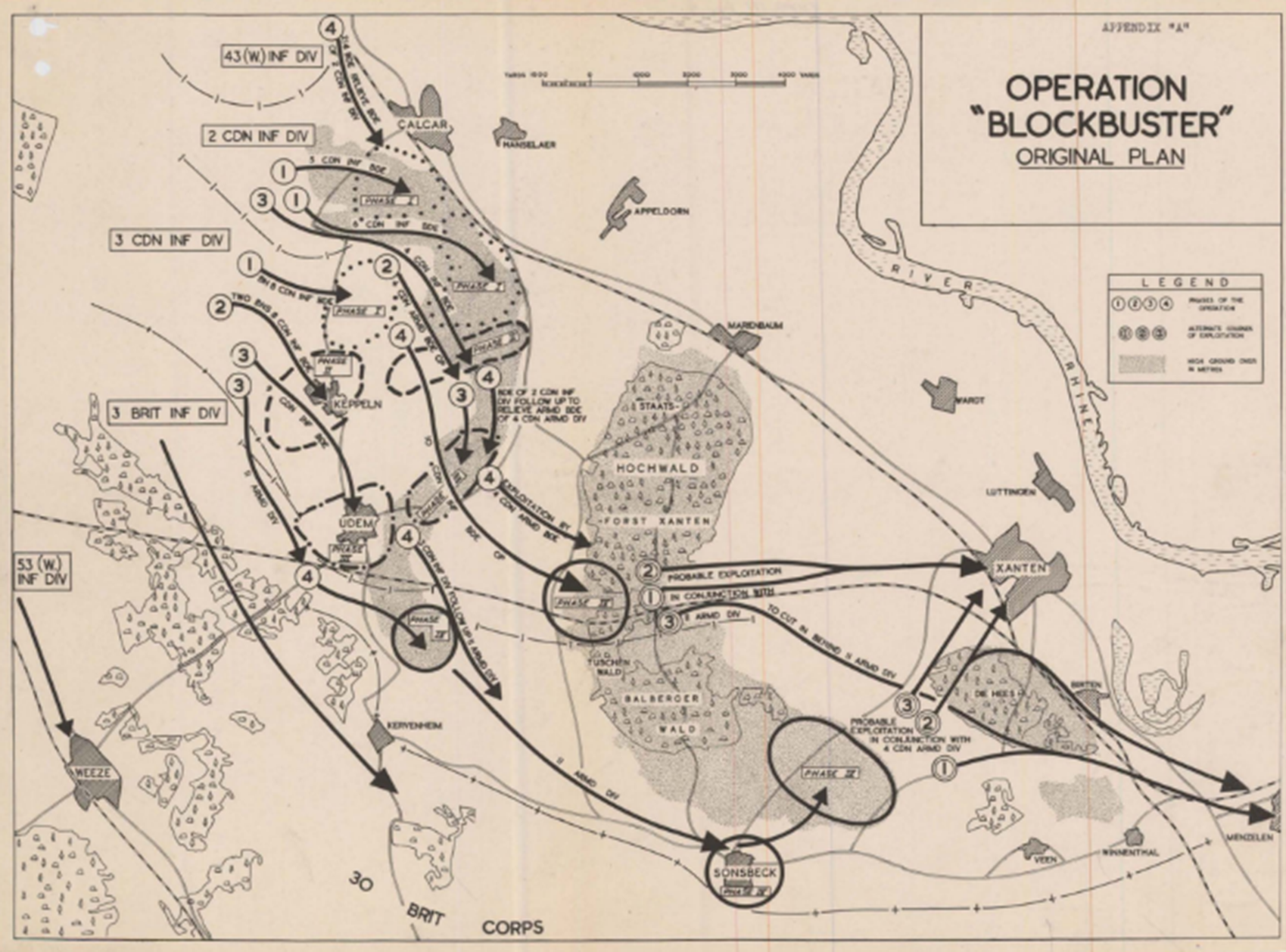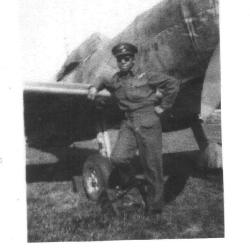By the winter of 1945, the Allies had moved across Western Europe towards Germany. Before reaching Germany’s interior, the Allies first had to cross the Rhine River. In order to clear the Rhineland of German forces, the Allies attempted a pincer operation— Canadian and British troops would attack from the north while American troops would attack from the south ultimately surrounding and cutting off the German forces. Due to poor weather and flooding, however, the plan advanced more slowly than desired. The Allies conceived a new plan to help speed up the capture of Germany: Operation Blockbuster. This plan went into affect on February 26, 1945. According to this new plan, Canadian forces would take the high ground south of Calcar and Udem, continue through the Hochwald Forest, and make their way to the cities of Xanten and Wesel. This would allow the Allies a passage over the Rhine and into the heart of Germany.
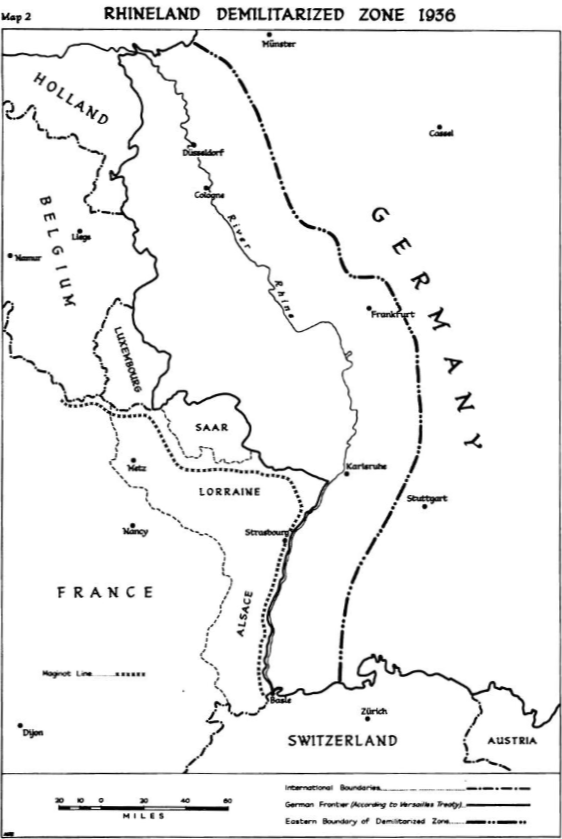
What is the Rhineland?
The Rhineland is an area of Western Germany that boarders France, Belgium and the Netherlands. The area is named after the Rhine River, which flows through the region. According to the Treaty of Versailles and the Loncarno Treaties, the Rhineland was to stay demilitarized. However, Hitler violated these treaties by stationing German troops in the region in 1936. For Canadian soldiers on the Western Front, the Rhineland was the first time fighting on German soil.
The Queens’s Own Rifles were among the regiments that took part in Operation Blockbuster. As part of the 3rd Canadian Division, they played a significant role in clearing the Rhineland of German troops. However, German forces would not leave the Rhineland without a fight and the resulting action proved deadly for members of The Queen’s Own Rifles. This article highlights the experiences of three members of the Queen’s Own Rifles who paid the ultimate sacrifice during the operation: Aubrey Cosens, Charles Nahwegezhic, and Eugene Robert Thomas.
“This will be the toughest scrap we’ve ever been in. A lot of us won’t make it. Those who do, well, they’ll remember it for a long time.”
—Major Dick Medland, A Company, 1st Battalion, Queen’s Own Rifles
Aubrey Cosens
Aubrey Cosens was born in Latchford in 1921 but spent most of his childhood living in Porquis Junction, Ontario. His father worked on the railway and Cosens followed suit, leaving school in 1938 to work as a section hand. At the beginning of the war, he tried to enlist in the Royal Canadian Air Force but was rejected. Instead, he enlisted with the Argyll and Southerland Highlanders of Canada in Hamilton. He served with them in Canada, Jamaica, and England. On August 1, 1944, Cosens was transferred to The Queen’s Own Rifles as a reinforcement and soon after was promoted to sergeant.
On February 26, 1945, Cosens and the other members of 16 Platoon, D Company were near Mooshoff, Germany. Their objective was to secure a farmhouse and two other nearby farm buildings. As they dug in near the buildings, German forces counterattacked. The platoon fought back, but their platoon commander was injured. Cosens stepped up and took charge of the other members of the platoon. He leapt onto a nearby tank and directed it to crash into the rear wall of the farmhouse. Cosens jumped off the tank and cleared all three buildings of the enemy. By the end, he took 20 Germans as prisoners. He then left to report to his company commander but, on his way, was killed by a German sniper. Cosens was only 23. For his actions, he was awarded the Victoria Cross, Canada’s highest medal for bravery in the Canadian honours system.
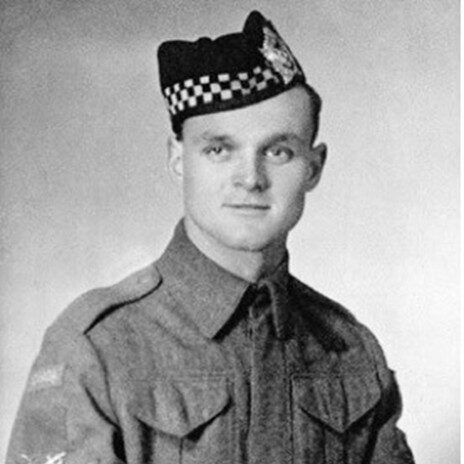
Charles Nahwegezhic
Charles Nahwegezhic was born on Sheguiandah First Nation in 1918. Before the war, he worked both as a farm labourer and a taxi driver. On November 22, 1940, he joined the Sault Ste Marie and Sudbury Regiment militia and subsequently enlisted in the army on June 10, 1941. While overseas, he was transferred to the Queen’s own Rifles on August 26, 1944.
During operation Blockbuster, Nahwegezhic was part of 7 Platoon, A Company. On February 26th, 1945, the platoon was near the village of Roland, Germany. The German forces heavily attacked the platoon and there were many casualties, including Nahwegezhic, who suffered a head injury. However, he continued advancing through the attack. Soon the platoon was told to withdraw, but Nahwegezhic stayed behind with his Bren gun providing cover for the rest of the platoon. As a result, the platoon was able to reorganize a successful counterattack. For his courage, he was awarded the Military Medal. Sadly, Nahwegezhic died of his wounds on February 28th, 1945, at the age of 26.
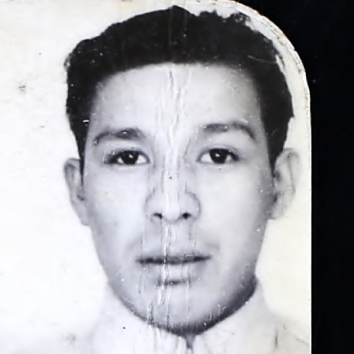
Eugene Robert Thomas
Eugene Robert “Bobby” Thomas was born in Oakville, Ontario in 1925. When he was young, the family moved to Montreal and his mother remarried. Thomas could speak both English and Spanish fluently and took a mechanics course before working as a clerk for the Dominion grocery store. He enlisted in Montreal on September 1, 1943. His mother was reluctant to let him enlist but she agreed after Thomas insisted. In June of 1944, while overseas, he was transferred to The Queens own Rifles where he worked as a medic.
By March 3, 1945, The Queens Own Rifles were nearing the end of their part in Operation Blockbuster. Their job that day was to clear the southern part of the Hochwald Forest near Udemerbruch. As the battalion pushed forward, they were met with heavy artillery fire and some individuals had to cross a heavily defended area full of mines. As a medic, Thomas would have been helping to ensure that injured members of the battalion received medical care. However, sometime during the advance, Thomas was shot by a sniper and instantly killed. He was only 20 years old.

Aftermath
Cosens, Nahwegezhic and Thomas were only three of the casualties that The Queen’s Own Rifles endured during their time fighting in the Rhineland. On the first three days of Blockbuster alone, 34 members of The Queen’s Own rifles were killed. By the end of the operation, over 5000 Canadians were killed, injured or missing. Cosens, Nahwegezhic and Thomas were all reburied at Groesbeek Canadian War Cemetery in the Netherlands alongside other Canadians who died in the Rhineland. Their personal sacrifice during Operation Blockbuster is a testament to the courage that Canadians showed in the final months of the European Theatre of War.
Article written by Anthony Badame for Honouring Bravery.
Sources
Ball, William C. The Regiment’s “Toughest Scrap”: Operation blockbuster, February 26 1945.
Cosens, Aubrey. The Queen’s Own Rifles of Canada Regimental Museum and Archive.
Cosens, Aubrey Personnel File . Library and Archives Canada
Mayer, P. A. (1945).OPERATION “BLOCKBUSTER”: The Canadian Offensive West of the Rhine, 26 Feb – 23 Mar 1945 (Preliminary Report), Canadian Military Headquarters.
Nahwegezhic, Charles Personnel File, Library and Archives Canada
Nahwegezhic, Charles, The Queen’s Own Rifles of Canada Regimental Museum and Archive.
Project 44. Interactive map of Operation Blockbuster.
Thomas, Eugene R. Personnel File, Library and Archives Canada
Thomas, Eugene Robert. The Queen’s Own Rifles of Canada Regimental Museum and Archive.
Thomas, Robert Eugene, Black Canadian Veterans Stories
War Diaries (1945). The Queen’s Own Rifles of Canada Regimental Museum and Archive.
Feature Image: A plan for Operation Blockbuster, Canadian Military Headquarters Report, 1947 (Government of Canada).

